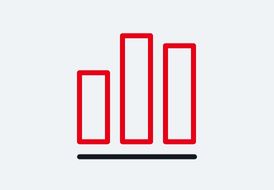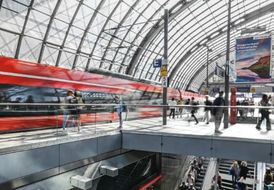Developments in the relevant markets
German passenger transport market
In passenger transport, our objective is to maintain our strong market position in the rail and bus transport market in Germany in the long term and to take advantage of certain market opportunities in Europe.
Passenger transport market in Germany / % based on volume sold | Growth rate | Market share | ||
2022 | 2021 | 2022 | 2021 | |
Motorized individual transport | +3.1 | +0.7 | 84.1 | 88.4 |
Rail passenger transport | +58.8 | +0.3 | 9.5 | 6.5 |
DB Group | +65.5 | –2.7 | 7.7 | 5.1 |
Non-Group railways | +34.8 | +12.9 | 1.8 | 1.4 |
Public road passenger transport | +32.5 | +0.0 | 6.0 | 4.9 |
DB Group | +11.9 | +8.8 | 0.5 | 0.5 |
Air transport (domestic) | +93.2 | –20.3 | 0.4 | 0.2 |
Overall market | +8.4 | +0.6 | – | – |
The data for 2021 and 2022 are based on information and estimates available as of February 2023.
In 2022, German passenger transport was still impacted by the effects of changing mobility behavior as a result of the Covid-19 pandemic. During the three years of the Covid-19 pandemic, people tended to prefer individual rather than public modes of transport. In the first third of 2022 in particular, demand for transport was below the pre-Covid-19 level. Demand for transport increased significantly during the course of 2022. In addition, measures such as the 9-Euro-Ticket and the nationwide fuel discount boosted passenger transport in the summer months. Overall, the German passenger transport market recorded noticeable growth in 2022. However, the extent and dynamics of the development were different in the individual market segments:
- Motorized individual transport continued on the path to recovery in 2022. While the volume sold in motorized individual transport decreased by about 13% in 2020 compared with 2019, it increased by about 0.7% in 2021 and by about 3.1% in 2022. In the course of 2022, motorized individual transport continued to benefit from the preference for individual transport based on the desire to protect against infection. In addition, the temporary fuel discount introduced by the Federal Government had a positive effect.
- Domestic air transport also recorded an enormous increase in demand in 2022. In particular the summer months, which are popular for travel, showed an increase in volume sold of about 93% in 2022. Despite the strong recovery, the market share remains at a very low level at 0.4%.
- Rail passenger transport recorded a very strong increase in volume sold of about 58% in 2022.
- Regional rail passenger transport benefited from the 9-Euro-Ticket from June to August 2022.
- Long-distance rail passenger transport was characterized by the return of private and business travelers. Development in 2022 was supported by extensive expansion of available offers of the railways. FlixTrain expanded its rail network with three new lines from May 2022, offering travel to a total of 70 destinations.
- Public road passenger transport also increased significantly. The 9-Euro-Ticket made a significant contribution to this, but public road passenger transport continued to suffer as a result of the lower number of commuter journeys. The increase boosted both intra-Group and external suppliers equally.
- Volume sold in long-distance bus transport more than doubled in 2022. This was due, on the one hand, to the severe supply restrictions of the previous year and, on the other hand, to the expansion of FlixBus services over the course of 2022.
- The market share increased slightly again.
German freight transport market
Freight transport market in Germany / % based on volume sold | Growth rate | Market share | ||
2022 | 2021 | 2022 | 2021 | |
Rail freight transport | +0.9 | +9.4 | 19.0 | 18.7 |
DB Group | –0.8 | +8.1 | 8.0 | 8.0 |
Non-Group railways | +2.2 | +10.4 | 11.0 | 10.7 |
Road freight transport | –0.5 | +3.8 | 72.0 | 72.2 |
Inland waterways | –6.0 | +4.0 | 6.5 | 6.9 |
Long-distance pipelines | +12.2 | –5.7 | 2.5 | 2.2 |
Overall market | –0.3 | +4.5 | – | – |
Data are based on information and estimates available as of February 2023. Volume sold in rail freight transport according to the Destatis definition of transport services that are primary freight carriers.
After a strong start to 2022, marked by baseline effects, demand growth slowed intermittently. The beginning of the negative trend was marked by the outbreak of the war in Ukraine, with the burden on the market environment resulting from a combination of various disruptive factors.
Significant rises in energy and fuel costs adversely affected transport operators in terms of costs. Energy-intensive sectors adapted production volumes as the increased factor costs on the market could not be passed on, which led to significant declines in transport volumes. Fossil energy carrier transport, on the other hand, showed strong growth as a result of increased use in power generation. The supply chain problems already present in the Covid-19 pandemic and the resulting shortages of materials, especially in the automotive and construction sectors, continued in the first half of 2022, but abated significantly as the year progressed.
In addition to global political and economic challenges, there was an ongoing acute shortage of personnel in the transport industry. Volume sold in freight transport in Germany was weaker than expected and was at the previous year’s level.
After a strong previous year marked by catch-up effects, rail freight volume sold started 2022 just as strongly, but demand waned significantly from March onwards. The performance in chemical and paper transport sectors which were primarily affected by the energy crisis was poor, but the steel industry also recorded significant declines. The expected strong recovery of car transport, which had collapsed during the Covid-19 pandemic to half the pre-pandemic level, was weaker due to the semiconductor shortage that was only resolved from the second half of 2022. Coal and earth and mineral oil transport, on the other hand, recorded a significant increase in volume. Transport of construction materials and combined transport also showed a moderate increase, with the trend leveling off markedly in the second half of 2022.
Overall, rail freight volume was slightly above the previous year’s level and market share also increased in 2022. Non-Group railways were drivers of growth and benefited particularly from the growth of combined transport, among other things. In contrast, the overall volume sold of DB Group companies was slightly below the previous year’s level, as these did not perform transport services to a large extent to stabilize the operating situation.
Road freight transport started 2022 almost as strongly as rail freight transport. In addition to baseline effects, this was due to positive economic stimulus and high order levels in the construction industry. Due to rising prices and weakening demand, the further course of the year resulted in slight declines in some cases and significant declines in other cases. The reasons for this were the weaker development in sectors dominated by trucks, such as mechanical engineering and consumer goods, but also in the chemicals sector.
Due to rising interest rates in the second half of 2022, the construction sector, which is very important for the road sector, recorded significant declines in orders.
As in the previous year, the performance of trucks registered outside Germany was significantly more positive than those registered in Germany, but overall performance on road declined slightly in 2022 and remained just below the previous year’s level. Road market share declined slightly.
The intermodal market share of inland waterway transport fell to a historic low in 2022. The first quarter saw strong growth in the coal, ores, stone and earth sectors. Container transport, which has less influence on the overall volume, also developed positively. The effects of low water in the Rhine from July, as a result of which vessels could either not travel at all or not at full capacity, caused a dramatic decline in volume sold. Although water levels did not quite reach the historical low level of 2018, they did not recover enough for a return to normal operations until September. Although volume sold increased significantly again in the last quarter due to strong demand for goods that are predisposed to inland waterways, inland waterway transport nevertheless closed the year with a significant loss.
European rail freight transport market
Development in the course of 2022 was noticeably influenced by the consequences of the war in Ukraine. Material shortages, disrupted supply chains, cost increases due to high energy prices and changed flows of transport had a negative impact on the market, particularly from the second quarter onwards. As a result, demand for transport fell, for example in the sectors predisposed to rail transport, such as steel and chemicals. The market was also impacted by the decline in traffic from and to Russia, among other things. Due to a change in energy policy in countries such as Germany, Poland and the Czech Republic, there was a sharp increase in coal transport. According to our own calculations, volume sold of European rail freight transport (EU 27, Switzerland, Norway and the United Kingdom) fell slightly overall. DB Cargo’s volume sold in Europe also declined slightly, but thanks to the positive development of DB Cargo companies in Poland, Romania and Italy, the decline was not as strong as the overall market.
International freight transport and logistics markets / % | Growth rate | |
2022 | 2021 | |
European rail freight transport (based on tkm) | –0.8 | +7.6 |
Figures are based on information and estimates available as of February 2023.


